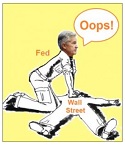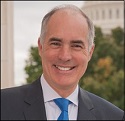-
Recent Posts
- It’s Time to Name the “Wall Street Financiers” in the Epstein Files
- Trump’s “Big Beautiful Bill” Is a Grotesque Giveaway to Fossil Fuel Billionaires While Adding $3.3 Trillion to Nation’s Debt
- Senator Chris Murphy Charges that Trump “Has Opened a Channel for Bribery”
- Congressman Casten: Trump’s Assault on the Rule of Law Is Causing Capital Flight Out of U.S. by Foreign Investors
- Trump’s Approval Rating Drops to 80-Year Low; IMF Says U.S. Tariffs Now Exceed the Highs During the Great Depression
- Nasdaq Has Lost More than 3,000 Points Since Trump’s First Full Day in Office in 2025; the Pain Has Barely Begun
- The Bond Crisis Last Week Was a Global No-Confidence Vote in U. S. President Donald Trump
- Trump’s Tariff Plan Guts $5 Trillion in Stock Value in Two Days; Senator Warren Calls for Emergency Action Before Markets Open on Monday
- Trump’s Attacks on Big Law, Universities, and the Media Have a Common Goal: Silence Dissent Against Authoritarian Rule
- Trump Administration Gives All Clear to Laundering Money through Shell Companies and Bribing Foreign Officials
- Four Megabanks on Wall Street Hold $3.2 Trillion in Uninsured Deposits – Which May Explain Senator Schumer’s Pivot to the GOP to Stop a Government Shutdown
- Here’s What Came Crashing Down Yesterday for Trump’s “Genius” Guy, Elon Musk: Tesla Stock, Access to Twitter (X), His Years of Secret Calls with Putin
- After Banning the Associated Press, Trump Is Now Targeting Specific Journalists That He Wants to See Fired
- Closely Watched Atlanta Fed Model Predicts Negative U.S. Growth in First Quarter
- Trump’s Gangster Diplomacy Makes Front Page Headlines Around the Globe
- Who Benefits Alongside Elon Musk If He Succeeds in Killing the CFPB: the Megabanks on Wall Street that Underwrite His Tesla Stock Offerings
- In Trump 1.0, the State Department Used Taxpayer Money to Publish a Book Elevating Elon Musk to a Superhero; It Was Funded by USAID, the Agency Musk Wants to Quickly Shut Down
- News Host Joy Reid Raises Threat of Trump Selling U.S. to Putin; Ten Days Later Her Show Is Cancelled
- Elon Musk’s DOGE Appears to Be Violating a Court Order; It Has Taken Down Hundreds of YouTube Videos that Educate Americans on How to Avoid Being Swindled
- Barron’s Releases Audio of Jamie Dimon Cursing Out His Workers at a Town Hall, as Dimon Plans to Dump Another One Million JPM Shares
- There’s One Federal Investigative Agency that Neither Trump nor Elon Musk Can Touch: It Just Opened an Investigation into DOGE
- Elon Musk’s Companies Were Under Investigation by Five Inspectors General When the Trump Administration Fired Them and Made Musk the Investigator
- Donald Trump Gives the Greenlight to Goldman Sachs and JPMorgan Chase to Return to Bribing Foreign Officials
- After Tech Geeks Built a Back Door to Loot Billions from FTX, Republicans Refuse to Investigate What Elon Musk’s Tech-Squad Did Inside the U.S. Treasury’s Payment System
- Former Prosecutor, Now U.S. Senator, Informs Tesla That CEO Musk May Be Violating Federal Law and to “Preserve All Records”
- Trump’s Hedge Fund Guy Is Now Overseeing the U.S. Treasury, IRS, OCC, U.S. Mint, FinCEN, F-SOC, and the Consumer Financial Protection Bureau
- As Elon Musk Begins Shutting Down Payments to Federal Contractors, a Strange Money Trail Emerges to His Operatives Inside the U.S. Treasury’s Payment System
- JPMorgan Chase Charged by Yet Another Internal Whistleblower with Cooking the Books
- We Asked Google’s AI Search Model, Gemini, Questions About the Fed and Wall Street Megabanks: It Got the Answers Dead Wrong
- With Trump and Melania’s Crypto Coins Likely to Raise Legal Challenges, Why Didn’t Trump Fire the SEC’s Inspector General in His Purge of IGs?
- Fossil Fuel Industry Could End Up Paying Tens of Billions for LA Wildfires and Deceiving the Public on Climate Change for Decades
- It’s Being Called the Biggest Grift by a President in U.S. History: Trump and First Lady Launch their Own Crypto Coins
- Trump Plans to Install a Fracking CEO to Head the Energy Department and Declare a National Emergency on Energy to Gain Vast Powers
- Fossil Fuel Money Played a Role in the Los Angeles Fires and the Push to Install Pete Hegseth as Secretary of Defense
- When It Comes to Wealth Retention in Retirement, Concrete May Be the New Gold
- Wall Street Watchdog Warns “Clock Is Ticking on a Coming Catastrophic Financial Crash”
- Wall Street Is Sending the Same Message to Americans on Fossil Fuel Financing that It Sent on Cigarettes: Drop Dead
- In a Six-Week Span, this Dark Pool with a Curious Past Traded 3.7 Billion Shares
- Wall Street’s Lobby Firm Hired Eugene Scalia of Gibson Dunn to Sue the Fed for Jamie Dimon
- Postmaster General Louis DeJoy Made $561,051 in Compensation in 2024, as Mail Costs Spiked and Delivery Deteriorated
- Fed Chair Jay Powell Sends a Bold Message to Trump and Tanks the Dow by 1123 Points
- The Head of Fixed Income at T. Rowe Price Makes the Scary Case for the 10-Year Treasury to Spike to 6 Percent
- $663 Billion in Cash Assets Have Gone Poof at the Largest U.S. Banks
- Donald Trump to Ring Bell at New York Stock Exchange Today as Hit List Posters Appear in Manhattan Targeting Wall Street CEOs
- Trump Has a Slush Fund to Prop Up the Dollar – Will He Use It to Prop Up Bitcoin Instead?
- A CEO Assassination; a Billionaire Heiress/NYPD Commissioner; a Secret Wall Street Spy Center – Here’s How They’re Connected
- Despite More than 1600 Tech Scientists Signing a Letter Calling Crypto a Sham, Trump Names a Crypto Cheerleader for SEC Chair
- The Fed Rings a Warning Bell: Hedge Funds and Life Insurers Are Reporting Historic Leverage
- Trump’s Nominee for FBI Director, Kash Patel, Has Businesses Financially Intertwined with Trump
- Donald Trump Is at Risk of Getting Named in a Fossil Fuels Conspiracy Lawsuit
Category Archives: Uncategorized
Casino Banking: Wall Street Mega Banks Traded More in their Federally-Insured Bank than the Total for their Bank Holding Company

By Pam Martens and Russ Martens: October 13, 2022 ~ When something happens for the first time in history at federally-insured banks, Congress and federal regulators need to pull their heads out of the sand and pay attention. We’re talking about the fact that in the second quarter of this year, trading revenues at federally-insured commercial banks eclipsed the trading revenues at bank holding companies – which typically include subsidiaries where traders actually have licenses to trade. This latest data on what is happening inside the nation’s largest federally-insured banks comes from the Office of the Comptroller of the Currency (OCC), see pages 2 and 3 here. The federally-insured banks generated a total of $10.3 billion in trading revenue in the second quarter versus $10.2 billion for the bank holding companies, or 101 percent of the bank holding company revenues. That’s never happened before according to the data provided by the … Continue reading
If a Stockbroker Had Jamie Dimon’s BrokerCheck Record, He’d Be Unemployable on Wall Street

By Pam Martens and Russ Martens: October 12, 2022 ~ The last thing that a stockbroker on Wall Street wants to have on his BrokerCheck record is a “Disclosure” item. BrokerCheck is the database maintained by Wall Street’s self-regulator, FINRA, which allows the public to peruse the past history of someone they might be considering doing investment business with on Wall Street. A “Disclosure” item means that a complaint has been brought against you and it describes the nature of the complaint and the status. In our more than three decades of using BrokerCheck, we have never seen a broker still employed with any major Wall Street firm who has listed even one criminal charge, let alone four – until we looked up the BrokerCheck Record for the Chairman and CEO of JPMorgan Chase, Jamie Dimon. Under his individual record, Dimon has listed two pending civil cases, four criminal cases, and … Continue reading
Nomi Prins’ New Book: “No One Wanted to Call the Fed’s QE a Ponzi Scheme. But It Was.”

By Pam Martens and Russ Martens: October 11, 2022 ~ Wall Street veteran Nomi Prins’ new book is being released today with a title that should give every member of the Senate Banking and House Financial Services Committees pause: Permanent Distortion: How the Financial Markets Abandoned the Real Economy Forever. The book does what neither of these Committees has done for the American people. It explains how the financial crash of 2008 unleashed an unbridled and unaccountable Fed as Wall Street’s permanent sugar daddy, distorting market functioning with its perpetual money spigot to the point that markets no longer function as a pricing mechanism or efficient allocator of capital but more along the lines of a Ponzi scheme for the rich. Prins writes: “Once central banks unleashed monetary policy to accommodate mega-banks, subsidize Wall Street financiers, and bolster global markets, the very idea of free and open markets and laissez-faire investing … Continue reading
Shhh! Don’t Tell the Fed or Mainstream Media that Systemic Contagion at Wall Street Banks Is Already Here

By Pam Martens and Russ Martens: October 10, 2022 ~ At Fed Chairman Jerome Powell’s last press conference on September 21 he said that there is “good reason to think that this will continue to be a reasonably strong economy.” Unfortunately, the U.S. can’t have a strong economy without strong banks willing and able to lend. And there are serious storm fronts in that area that the Fed Chair and mainstream media are choosing to ignore. Last week multiple news outlets raised the question as to whether the troubles at Credit Suisse signaled another “Lehman moment.” (See here, here, and here, for example.) A “Lehman moment” refers to the former 158-year old Wall Street investment bank, Lehman Brothers, collapsing into bankruptcy on September 15, 2008 during a widening financial crisis on Wall Street. Because Lehman was the only major Wall Street firm that the Fed allowed to collapse into bankruptcy (rather … Continue reading
All Eyes Are on Credit Suisse; But Media Blacked Out Data from the New York Fed Suggest Contagion from Nomura Is Another Threat

By Pam Martens and Russ Martens: October 7, 2022 ~ Nomura Holdings is tiny compared to the mega banks on Wall Street. According to its website, it had just $384 billion in assets as of March 31, 2021. On the same date, JPMorgan Chase had $3.2 trillion in assets. But for reasons that neither the Federal Reserve nor Congress have yet to explain, a unit of Nomura was allowed to borrow trillions of dollars in emergency repo loans from the Fed beginning on September 17, 2019 – months before there was any COVID crisis anywhere in the world. The chart above shows that in the last three months of 2019, Nomura borrowed $3.7 trillion cumulatively under the Fed’s emergency repo loan program, topping the amount borrowed by JPMorgan Chase by $1.11 trillion. The loan amounts come directly from the emergency repo loan data being released quarterly by the New York Fed, … Continue reading
New Study: Wall Street Banks Are Doubling Down on Risk by Selling Credit Default Swaps on their Risky Derivatives Counterparties

By Pam Martens and Russ Martens: October 6, 2022 ~ Last Thursday, while news outlets focused on videos of the devastating impact of Hurricane Ian on the southwest coast of Florida, two researchers at the Office of Financial Research published a breathtaking and almost surreal analysis of how the mega banks on Wall Street are once again doubling down on unprecedented risk with derivatives and threatening the financial stability of the U.S. The report was ignored by mainstream business media. The Office of Financial Research was created under the Dodd-Frank financial reform legislation of 2010 to make sure that Wall Street mega banks could never again ravage the economy and financial system of the United States — as they did in 2008 – by engaging in reckless derivative trades and toxic bets. OFR describes its mission as follows: “Our job is to shine a light in the dark corners of the … Continue reading
Cape Coral: A City of 204,000 in Florida Remains 86 Percent Without Power on Day Eight Since Hurricane Ian Hit

By Pam Martens and Russ Martens: October 5, 2022 ~ If a major fire occurs in most cities and towns across America, there is a standing procedure to quickly call for mutual aid from other fire departments to achieve a speedy and safe resolution. But when it comes to the Lee County Electric Cooperative (LCEC) that provides electricity to the city of Cape Coral, Florida, something has gone terribly wrong in the process of calling for that mutual aid in a timely manner after one of the most devastating hurricanes in Cape Coral’s history. Cape Coral is a city of 204,000 residents according to the U.S. Census Bureau. LCEC has been providing electric power to Cape Coral since its first six model homes were constructed in 1958 – a span of 64 years. But for days after Hurricane Ian hit the Southwest coast of Florida on Wednesday, September 28, as a … Continue reading
Credit Suisse and the Fed’s Plunge Protection Team

By Pam Martens and Russ Martens: October 4, 2022 ~ At 6:53 a.m. this morning (ET), Dow futures were up 454 points. That followed the Dow Jones Industrial Average gaining 765 points yesterday. No one who has been a trader on Wall Street or a stock broker for multiple decades believes this rally is real. Wall Street veterans are thinking that either the Fed’s plunge protection team or the Treasury’s plunge protection team is behind the rally. Equally unbelievable, as the chart above indicates, is the fact that the major mega banks on Wall Street closed in the green yesterday. Many of these are counterparties to Credit Suisse derivatives and thus subject to the potential for contagion. Until everyone who works on Wall Street is 25 years old and too young to remember what happened in 2008 after Citigroup began to quake, Wall Street traders are not going to believe that … Continue reading
Here’s the Chart of the Global Bank Causing Panic in Markets This Morning

By Pam Martens and Russ Martens: October 3, 2022 ~ The Swiss global bank, Credit Suisse, which is a derivatives counterparty to major Wall Street banks and U.S. insurers, raised alarm bells in markets on Friday and is raising more anxiety this morning. Its 5-year credit default swap (CDS), a measurement of its risk of defaulting on its debt, jumped to 250 basis points on Friday and traded as high as 350 basis points in early morning trade today. The big move in the CDS on Credit Suisse is further impacting the price of its common stock. The shares closed on Friday in New York at $3.92, just pennies away from its all-time low, then dropped another 11 percent in early morning trading in Europe today. When a major derivatives counterparty begins to see a blowout in its credit default swaps, that impacts the stock prices of all major Wall Street … Continue reading
Two Senators – a Republican and a Democrat – Testify to Senate Banking Committee on China’s Threat to U.S. National Security and Competitiveness

By Pam Martens and Russ Martens: September 30, 2022 ~ Yesterday, Senator Robert (Bob) Casey, Jr. (D-PA) and Senator John Cornyn (R-TX) testified before the Senate Banking Committee. At a time when there is little that the two political parties can agree on in Congress, it was refreshing to hear these two Senators from different parties earnestly explain the threat that China’s ambitious agenda poses to the U.S.; how outward investment by U.S. corporations is furthering China’s agenda; and outline legislation to deal with the threat. Senator Casey explained the problem as follows: “For decades, the United States has steadily ceded its manufacturing power to other countries, particularly foreign adversaries, like the Chinese Communist Party (CCP) and the Russian Federation. Outsourcing our manufacturing and supply chains has put our economic and national security at risk. Unfortunately, the pandemic exacerbated this problem, as we experienced acute shortages of things like PPE and … Continue reading

